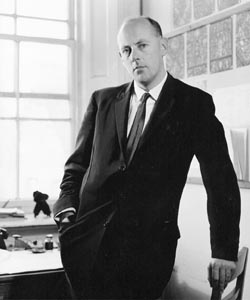 I came across Dr. Tatum, (shown in the center in the picture to the left), because of the excellent sets of class notes he wrote for his class in electricity and magnetism at the University of Victoria. At the time the picture was taken, he was a professor of astronomy at Radley College. The history of Radley says the following about Dr. Tatum:
I came across Dr. Tatum, (shown in the center in the picture to the left), because of the excellent sets of class notes he wrote for his class in electricity and magnetism at the University of Victoria. At the time the picture was taken, he was a professor of astronomy at Radley College. The history of Radley says the following about Dr. Tatum:'And at this point the most distinguished astronomer ever to teach at Radley took up his post as Head of Physics. This was Jeremy B. Tatum, fresh from a senior post in Astrophysics at Victoria University in Canada.[3]"
Education
Dr. Tatum did his PhD research[9] at the University of London Observatory in 1960. He did his postdoctoral work[10] at the Dominion Astrophysical Observatory before moving on to teach at Radley College[11].
Career
In addition to teaching electricity and magnetism, Dr. Tatum worked in astrophysics and was something of an expert on birds! It had never occurred to me that a physicist could work in the field of ornithology, although it makes perfect sense. Dr. Tatum authored articles on bird navigation and the Coriolis force as well as an article on calculating the volume of a bird's egg. His articles and letters appeared in ornithology journals such as "The Auk", "The Condor", and "Bird Banding"[5][6][7]. In his article on the Coriolis force, he thanks Sir Denys Wilkinson for stimulating converstaions[4]. Sir Denys is a knighted nuclear physicist! He's the rather dapper looking physicist shown below the interesting bird journal cover pictures.
Dr. Tatum frequently wrote letters to journals on a variety of topics including bird collecting and grammar[8].
As a final aside, Dr. Tatum also wrote about the acoustics of meteor fireballs and about locating fragments of meteors. He proposed that the shock waves produced by the meteor falling to earth might be detectable by seismograph allowing the track of the meteor to be determined. See the second list of references for several of these articles, (many of which are free from NASA).
Locations
View JB Tatum in a larger map
References:
1. http://www.astro.uvic.ca/~tatum/index.html
2. http://www.astro.uvic.ca/~tatum/elmag/em01.pdf
3. http://100radleyobjects.wordpress.com/transits-of-venus/
4. http://en.wikipedia.org/wiki/Denys_Wilkinson
5. http://www.jstor.org/action/showPublication?journalCode=birdband
6. http://www.jstor.org/action/showPublication?journalCode=auk
7. http://www.jstor.org/action/showPublication?journalCode=condor
8. http://articles.adsabs.harvard.edu/cgi-bin/nph-iarticle_query?1972Obs....92..147T&classic=YES
9. http://articles.adsabs.harvard.edu/cgi-bin/nph-iarticle_query?1961MNRAS.122..311T&defaultprint=YES&page_ind=0&filetype=.pdf
10. http://articles.adsabs.harvard.edu/cgi-bin/nph-iarticle_query?1965PDAO...12..425T&defaultprint=YES&filetype=.pdf
11. http://articles.adsabs.harvard.edu/cgi-bin/nph-iarticle_query?1968MNRAS.141...43T&defaultprint=YES&filetype=.pdf
Other articles by and about Dr. Tatum
Fireballs: Interpretation of Airblast Data
http://articles.adsabs.harvard.edu/cgi-bin/nph-iarticle_query?1999M%26PS...34..571T&defaultprint=YES&filetype=.pdf
A hitherto unrecorded fragment of the Bruderheim meteorite
http://adsabs.harvard.edu/full/1990JRASC..84....1T
Tracking a Fireball from Eyewitness Accounts II
http://adsabs.harvard.edu/full/2005JRASC..99..177T
Asteroid named after Dr. Tatum
http://en.wikipedia.org/wiki/3748_Tatum



Comments
Post a Comment
Please leave your comments on this topic: